How To Make Skin Glow In Photoshop

Like shooting fish in a barrel Soft Glow Consequence With Photoshop
Soft glow effects are a smashing way to enhance your photos, especially portrait shots, and creating them in Photoshop is easy. Yet the steps you take to create them can mean the difference between a static result (meaning i that can't easily be changed or edited later) and one that's much more flexible, where you tin can experiment and fine-melody the upshot until you become it looking but correct.
Both ways of creating the soft glow event can exist completed very rapidly, but which i you choose volition depend a lot on your electric current skill level and how comfortable y'all are with Photoshop's more advanced features (like Smart Objects and Smart Filters).
In this tutorial and the next, I'll show you both ways of doing things, outset here with the static version that's best for beginners. In the next tutorial, nosotros'll larn how to create the exact same effect only with much more control over the terminal result.
Even if you lot're new to Photoshop, I encourage you to try out both ways of adding a soft glow to your images to get a feel for how powerful and flexible Photoshop tin exist once yous go just a piddling bit beyond the nuts. Every bit always, I'll encompass everything step-past-step so no affair what your skill level, you tin can hands follow forth.
If you lot desire to jump direct into the more than advanced version, check out the next tutorial in this series, Editable Soft Glow With Smart Filters In Photoshop. Otherwise, permit's begin with the nuts!
Hither'southward the photo I'll be using (woman in field portrait photograph from Shutterstock):

The original epitome.
Here'south how it volition look with the glow applied. Not but does the effect assist to soften the photo, including the adult female'due south skin, merely it also enhances the overall dissimilarity and makes the colors appear more than vibrant:
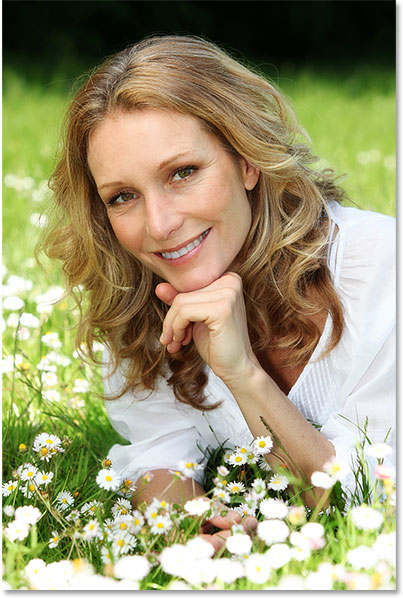
The final issue.
This tutorial is part of our Portrait Retouching collection. Let'southward get started!
Step 1: Indistinguishable The Background Layer
With my image newly opened in Photoshop, if we wait in my Layers console, we see the photo sitting on the Groundwork layer, currently the merely layer in my document:
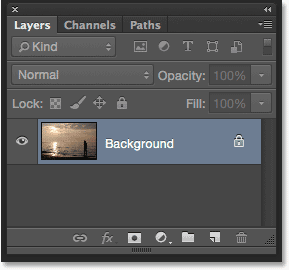
The Layers panel showing the photo on the Background layer.
The first thing we demand to do for our soft glow effect is make a copy of the Background layer, and the easiest manner to do that is to click on the Background layer and elevate it downwardly onto the New Layer icon at the lesser of the Layers panel (it's the 2nd icon from the correct):
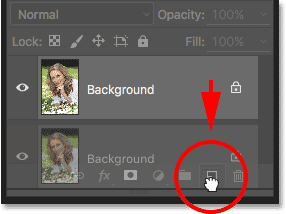
Dragging the Background layer onto the New Layer icon.
Release your mouse push button when your hand cursor is direct over the New Layer icon. Photoshop will make a copy of the Background layer, name the new layer "Background copy" and place it above the original:
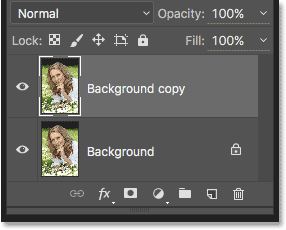
The "Background copy" layer appears above the original Groundwork layer.
Step two: Rename The New Layer
Information technology's e'er a good thought to rename layers in your Layers panel so you have a better sense of what's on each layer and what it'southward being used for. Permit's give the "Background copy" layer a more descriptive name. To rename a layer, simply double-click straight on its name in the Layers console. This will highlight the current proper name:
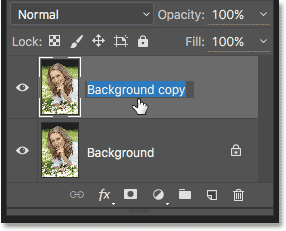
Double-clicking on the proper name "Background copy" to highlight it.
Since we'll be using this layer to create our soft glow event, let's name it "Soft Glow". Printing Enter (Win) / Return (Mac) on your keyboard when you're done to accept the name change:
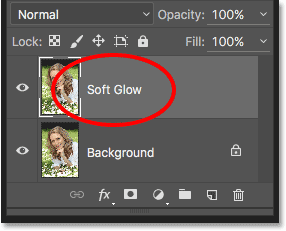
The "Background re-create" layer is at present the "Soft Glow" layer.
Step 3: Utilize The Gaussian Blur Filter
To create the actual soft glow effect, we'll beginning utilise some blurring to the "Soft Glow" layer. And then we'll modify the fashion the blurred layer mixes with the original image below information technology by irresolute its blend mode.
To blur the layer, nosotros'll use Photoshop's Gaussian Blur filter. Go upward to the Filter menu in the Carte du jour Bar along the superlative of the screen, cull Mistiness, and then cull Gaussian Blur:
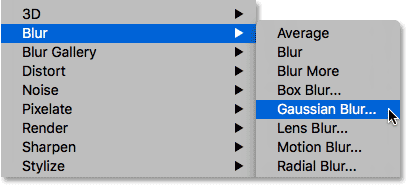
Going to Filter > Blur > Gaussian Blur.
This opens the Gaussian Blur dialog box, which lets the states control the amount of blur being practical to the layer using the Radius slider along the bottom. The farther you drag the slider to the right, the stronger the blur result will appear. Photoshop gives united states of america a live preview of the effect in the certificate, then keep an eye on your image as you drag the slider to approximate the results.
We don't desire to blur the image so much that our subject becomes unrecognizable. We're just trying to soften things up a bit, and so lower radius values tend to piece of work best. Keep in mind, though, that the blur amount that works all-time for your specific image may be different from mine and will depend a lot on its size, with larger photos needing more blurring than smaller ones. More often than not, for a subtle glow upshot, a radius value of somewhere around 10 pixels should piece of work well:
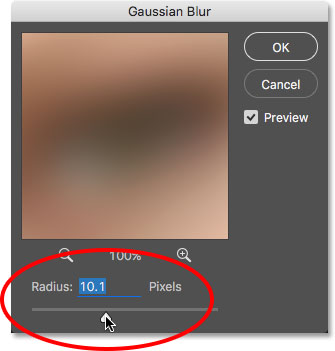
For a subtle glow, use smaller radius values.
Here'southward what my blur effect looks similar with a radius value of x pixels. Notice that while the photo looks softer than information technology did before, we can still brand out plenty of detail. We'll see even more than particular in one case we change the layer'due south alloy mode in the next step:

The blurring effect with a radius of ten pixels.
For an even softer, more dream-similar glow outcome, endeavor a larger radius value of around twenty pixels:
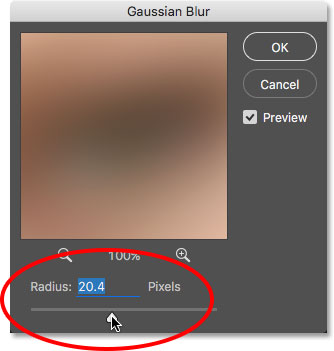
For a more dream-like glow, utilize a larger radius value.
Here's my blurring consequence using a 20 pixel radius. We can still make out item in the photo, simply the blurring is definitely stronger this time. Choosing the correct amount of blur is actually a personal choice and will depend on the image. In my case, I think this is also much then I'll go with the smaller 10 pixel radius. When you're happy with the results, click OK to close out of the Gaussian Mistiness dialog box:

The blurring effect with a radius of 20 pixels.
Footstep 4: Change The Alloy Fashion To Soft Light
Now that we've blurred the "Soft Glow" layer, let'southward change the way it interacts with the original image on the Background layer below information technology. We do that by changing its blend mode. Y'all'll detect the Alloy Mode selection in the upper left of the Layers console. By default, it's set to Normal. Click on the word "Normal" to bring up a menu of other blend modes and choose Soft Low-cal from the list:
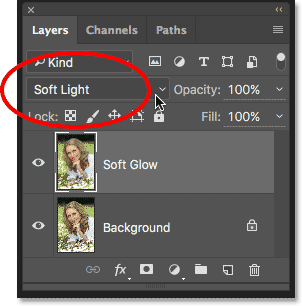
Changing the layer blend fashion from Normal to Soft Low-cal.
The Soft Low-cal alloy manner in Photoshop does two things; it boosts the overall dissimilarity in the image, and it enhances the colors, making them appear more vibrant. Hither's my prototype with the blend mode set to Soft Calorie-free, giving everything a warm, subtle glow:
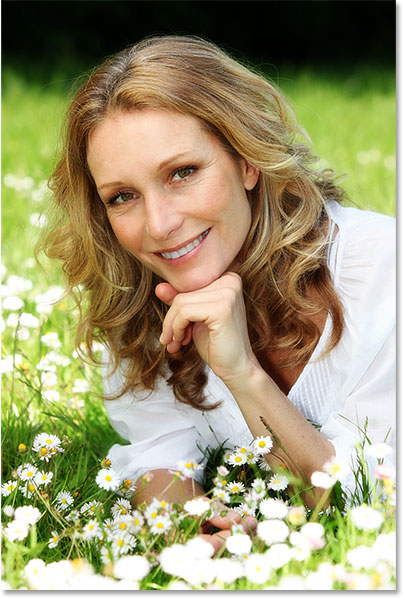
The effect using the Soft Lite alloy mode.
For a stronger event, try the Overlay blend mode instead. The Overlay blend fashion is very similar to Soft Light, boosting contrast and color, but where Soft Light is more than subtle, Overlay is more intense:
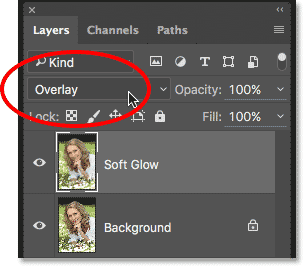
Changing the blend mode from Soft Light to Overlay.
Here's my event with the Overlay blend mode. Overlay may work better with a different image, simply in this instance, it'due south too strong so I'll become with Soft Light instead:
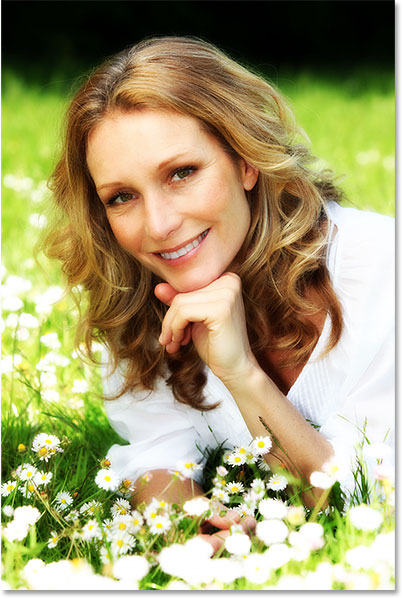
The consequence using the Overlay alloy fashion.
Step five: Lower The Layer Opacity
To fine-tune the result, simply lower the layer's opacity. You'll find the Opacity option in the upper right of the Layers panel, direct across from the Blend Mode choice. The default opacity value is 100%. The more you lower it, the more the original photo below the "Soft Glow" layer will show through. In other words, nosotros'll see more of the original image and less of the blurred image.
To change the opacity value, click on the small arrow to the right of the current value, then elevate the slider. I'll lower mine to effectually 75%, but over again, you'll want to keep an eye on your image equally you drag the slider to judge the results:
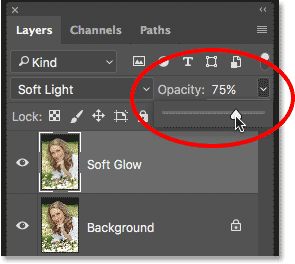
Lowering the opacity of the "Soft Glow" layer.
Here, afterward lowering the opacity, is my final soft glow issue:

The last consequence.
And at that place we have it! That's the quick and easy way to add a soft glow effect to an epitome with Photoshop!
But, now that I'm done, well, what if I don't really like the result? I went with a subtle glow, simply what if a stronger, more "dreamy" glow would take worked improve? How can I get back and modify it? I mean, I tin can easily change the alloy fashion from Soft Low-cal to Overlay (and vice versa), and I tin try irresolute the layer's Opacity value, but that'southward not actually what I desire to do. I want to go back and adapt the amount of blurring I practical with the Gaussian Blur filter way back in Step 3. How practise I do that?
The brusk answer is, I can't, and that's where the trouble with this fashion of creating the soft glow upshot comes in. As before long as nosotros clicked OK to close out of the Gaussian Blur filter, we committed the blur result to the layer. In other words, we made a permanent modify, or at least, one that tin can't easily exist undone. A better way to work would exist to keep the unabridged issue, including the Gaussian Mistiness filter, fully editable from start to finish. That way, even subsequently the result is completed, we could still get dorsum and try different mistiness amounts to make sure nosotros're getting the best effect possible.
So how do we do that? Nosotros do information technology by taking advantage of Photoshop's powerful Smart Objects and Smart Filters. They may sound intimidating, just they're actually very simple to use. In fact, they're every flake every bit easy to utilise every bit normal layers and filters in Photoshop, but they give u.s.a. much more than flexibility.
In the adjacent tutorial, we'll learn how to create this verbal aforementioned soft glow effect while keeping every step completely editable. So if you're ready to take your Photoshop skills to the next level, head on over to the Editable Soft Glow With Smart Filters tutorial. See y'all there!
Other Stuff
© 2022 Photoshop Essentials.com.
For inspiration, not duplication.
Site design by Steve Patterson.
Photoshop is a trademark of Adobe Systems Inc.
Source: https://www.photoshopessentials.com/photo-editing/easy-soft-glow-effect-with-photoshop/
Posted by: rodriguezbusbar.blogspot.com

0 Response to "How To Make Skin Glow In Photoshop"
Post a Comment